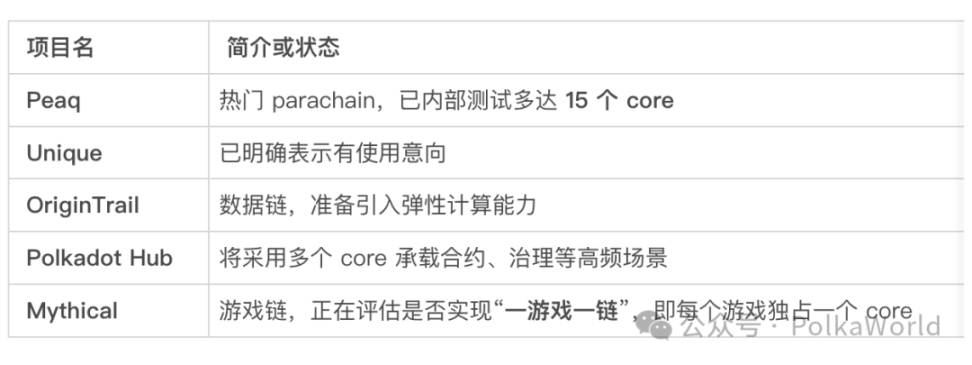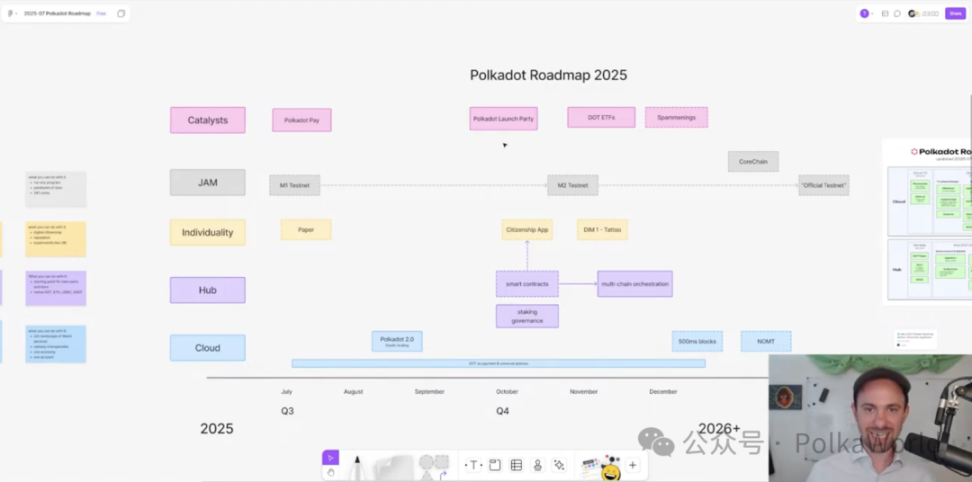Latest! Polkadot updates its 2025 roadmap, with several core products set to launch soon!

Hello everyone, welcome to the Polkadot 2025 roadmap article.
Today, we will start from the basics and give you a comprehensive understanding of Polkadot's current development. Over the past four years, Polkadot has continuously evolved and has gradually grown into a powerful Web3 application engine. However, not everyone has been able to keep up with this process in real time, nor is it always widely recognized.
Meanwhile, we are pleased to see more and more new friends joining the Polkadot community, starting to pay attention and ask: "What exactly is happening with Polkadot?"
Therefore, in this content, we will sort out Polkadot's latest roadmap together, focusing on several key components:
- Polkadot Cloud
- Polkadot Hub
- JAM (Join-Accumulate Machine)
- Individuality
Combined with several core release plans that have a significant impact on the market, we will help you see the overall direction and transformation path of Polkadot.
Before we officially begin, I would like everyone to remember two keywords: Polkadot Cloud and Polkadot Hub.
Technology is always evolving, but more important than technology is the vision and future we are building.
In the Web3 world, we see all major ecosystems iterating and upgrading, but the more important question we should ask is: What kind of future are they actually building?
At Polkadot, our answer is:
To build a globally distributed, scalable, and composable on-chain computing platform — that is, Polkadot Cloud and Polkadot Hub.
You can think of Polkadot Cloud as the AWS or Google Cloud of the Web3 world: it is a feature-rich, multi-service network system; in the future, you will be able to access various Web3 application services within it, such as:
- Identity systems
- Gaming and content platforms
- Real World Assets (RWA)
- Decentralized Finance (DeFi)
- Data and storage services, etc.
These services are natively interconnected and collaborative, forming the Web3 service ecosystem network envisioned by Polkadot.
This is exactly why we keep emphasizing the keyword: interoperability. Unlike other ecosystems that treat "interoperability" as a later patch, Polkadot has built interoperability into its underlying architecture from the very beginning.
In fact, since 2021, Polkadot has already achieved:
- Shared Security mechanism
- Parachain deployment mechanism
- Efficient cross-chain communication protocol (XCM)
This has laid the technical foundation for us to build a Web3 cloud service network today.
Of course, any new technology will inevitably face challenges in its early stages. We have also gone through repeated observation, adjustment, and optimization.
It is precisely based on these practical experiences that we further proposed: Polkadot 2.0.
You can think of Polkadot 2.0 as an upgraded version of the Polkadot Cloud architecture. Its core concept is: anyone can build a Web3 blockchain through the Polkadot SDK and deploy it as a service on the Cloud.
These chains are called Parachains, and they are service modules on Polkadot Cloud that can be invoked and used by any user or other chain in the ecosystem.
We can further understand: Polkadot Cloud is a network composed of countless Web3 services, these services are natively interoperable, and ideally, users only need one account to seamlessly use all services.
In today's roadmap, the first major milestone to mark is: Polkadot 2.0 is about to launch.
Polkadot 2.0: Late August to Early September 2025
Next, let's get to the main topic and explain in detail the core functions of Polkadot 2.0, and give the expected launch timeline based on the current development progress.
If you want to quickly explain to others what Polkadot 2.0 is, you can simply say: it is a comprehensive upgrade of the Polkadot network's capabilities, bringing stronger execution and computing resources to Polkadot and all parachains.
Structurally, Polkadot 2.0 contains three key technical modules, two of which have already been officially launched, and the third is in preparation.
✅ The two features that have already launched:
1. Agile Coretime
This is a brand new resource leasing mechanism, with the core idea being:
Chains can rent Polkadot's core execution resources on a monthly basis, just like renting cloud servers.
Currently, all parachains have switched to operating in the "coretime market," flexibly purchasing execution time in this way. This makes resource allocation more market-driven and greatly improves overall sustainability.
2. Async Backing
This was the earliest protocol upgrade introduced, making block production more flexible:
- Block production time can be fast or slow;
- Block size and frequency can also be adjusted as needed;
- The entire system has entered the era of elastic block production.
Currently, all parachains have implemented 6-second block production by default, with the ability to further accelerate, laying the foundation for future high-frequency applications.
The third feature about to launch: Elastic Scaling
This feature will truly bring the "performance explosion" moment of Polkadot 2.0:
If a chain needs higher computing power or greater data throughput, it can rent multiple cores as needed.
- No longer fixed resources, but "rent as much as you use";
- Supports different applications to dynamically scale execution capabilities according to their own needs.
Currently, this feature is undergoing final network stability testing. According to feedback from core developers, it is expected to go live in late August. Considering it is already July, even with a slight delay, we are very likely to see the official release by the end of August or early September.
What will Polkadot 2.0 (or Polkadot Cloud 2.0) bring?
It will reshape the market mechanism of core resources, with the following characteristics:
- Core resources are no longer "bound," but can be freely combined;
- Parachains can flexibly obtain computing resources according to their own business needs;
- Improves the economic efficiency and service capacity of the entire Polkadot network.
Who is ready to use Elastic Scaling?
Several projects have already expressed clear intentions and even conducted internal testing:

In addition, a number of projects are in line waiting to go live, including:
- Hydration
- Frequency
- Mandala
- Polimec
- Vbrick
These projects have all indicated a need for multiple cores and are ready to connect to Elastic Scaling.
It is worth mentioning that Mythical migrated from Ethereum to Polkadot mainly because Ethereum could not meet their high-frequency trading and real-time operation needs, while Polkadot's upcoming elastic scaling mechanism was a key motivation for their migration.
Current time expectations
In summary, the complete delivery timeline for Polkadot 2.0 can be tentatively set as:
Expected launch: Late August to early September 2025
We can mark this key time point as a core milestone in the roadmap.
Polkadot Hub: Mid-September to October
Next, we will explain another major topic: Polkadot Hub.
Polkadot Hub is the entry point for new users and developers into the Polkadot ecosystem. You can think of it as Polkadot's "main entrance" or "user center."
On the Hub, users can:
- Hold native assets such as DOT, ETH, USDC, USDT, etc.;
- Deploy and use smart contracts;
- Participate in staking and governance operations;
- Use integrated cross-chain bridges to interact with other chains.
In other words, Polkadot Hub brings together all key functions and is the core platform for users to participate in the Polkadot network.
The relationship between Polkadot Hub and Polkadot Cloud
Polkadot Cloud and Hub are complementary parts:
- Cloud provides a rich Web3 service ecosystem;
- Hub is the starting point for every user and developer — here you have an address, assets, and begin to explore the entire network.
The two core functions of Polkadot Hub
1. Staking and Governance module
- Currently deployed to the testnet Paseo;
- Expected to be deployed to the Kusama testnet soon;
- Technical preparations are basically complete, planned to go live in mid-September.
However, there is some uncertainty about this timing. Some large centralized exchanges have been slow to respond to this upgrade and have recently requested a delay so they can complete integration on the launch day.
Therefore, although the target is to go live in mid-September, it may ultimately be delayed to October to avoid impacting ecosystem operations.
2. Smart Contracts
- Successfully deployed on Kusama;
- Currently being tested through hackathons and other means, collecting developer feedback;
- The function itself has been developed, and the current priority is optimizing the developer experience.
The mainnet launch time has not yet been determined, but overall progress is similar to the Staking module, and it is expected to go live in September or October as well.
This contract platform is based on the brand new Polkadot virtual machine PolkaVM, aiming to provide higher performance than the Ethereum Virtual Machine (EVM). Currently, PolkaVM does outperform EVM, and further performance optimization will continue in the future.
Upcoming feature: XCM Orchestration (Multi-chain Orchestration)
This is the next step in the combination of smart contracts and XCM (cross-chain messaging protocol) capabilities.
Imagine the following:
- Users can use smart contracts on the Hub to call services on other chains in the Cloud;
- XCM is Polkadot's native cross-chain communication protocol, supporting cross-chain calls, information synchronization, asset transfers, etc.;
- The realization of this capability lies in multi-chain orchestration, building a truly interoperable on-chain network.
This feature has not yet announced a clear timetable, but it is in development, and the team is also studying XCM precompiles. The possibility of going live is getting closer and is worth paying attention to.
Summary of time nodes (estimated)

Other Cloud features in progress (time undetermined)
In addition to the main features already announced, Polkadot Cloud has two important user experience upgrades steadily advancing, although no specific launch time has been set, their long-term significance is critical.
1. DOT as a unified payment method (DOT-as-Payment)
The goal is to make DOT a universal payment medium in the Polkadot ecosystem. In the future, no matter which chain's service users use within the ecosystem, they can pay directly with DOT without converting assets.
2. Universal Address system
The goal is to achieve "one address for all": users only need one address to interact across multiple chains, manage assets, and participate in governance, greatly simplifying on-chain identity and account management.
These two features are gradually being promoted in the ecosystem, and more and more parachains are beginning to adopt this standard. Although the migration cost is high, under the guidance of the Web3 Foundation and core technical teams, chain-level support is steadily increasing.
For example, Hydration is one of the important projects that recently completed DOT payment and universal address integration.
Spamming performance test plan: End of 2025
In December 2024, Polkadot completed a historic experiment on the Kusama network, setting a record of 143,000 transactions per second (TPS).
- About 20–23 cores were used at the time;
- Based on this ratio, if all 100 Polkadot cores are used, it could theoretically reach 500,000 to 600,000 TPS;
- However, since all core resources on the mainnet are leased out, it is difficult to reproduce this test scenario, and thus a million-level TPS test has not yet been verified on the mainnet.
In the future, we may see:
- Another high-intensity transaction test on Kusama;
- Or use the existing parachain network to conduct "simulated attack" stress tests in real application environments.
Although this is still speculative, such tests can be regarded as one of the ecosystem's "catalyst events." We expect to see a similar test as early as the end of 2025, which, if achieved, would be a strong market signal.
NOMT integration: Time undetermined
Recently, Web3 Foundation or Parity Technologies reached a cooperation with Polkadot co-founder Robert Habermeier to integrate his newly developed technology — NOMT — into the Polkadot SDK.
This technology aims to solve a key bottleneck in blockchains: insufficient storage read performance.
- After leaving Parity, Robert focused on this research direction and designed a new structure;
- The read efficiency of the NOMT system is said to be more than 10 times that of existing solutions;
- It has now been confirmed that it will be officially integrated into the Polkadot SDK.
Although there is no clear timetable, it can be confirmed:
- This will be another magnitude-level improvement in Polkadot's underlying performance after elastic scaling;
- If spamming tests are conducted again in the future, combined with the NOMT breakthrough, it is expected to achieve 1 million TPS (1M TPS) for the first time.
Let's continue to the next topic: Individuality.
Individuality: Bold prediction that Gavin will release major progress at this year's Web3 Summit
It is sometimes also called "Proof of Personhood." Essentially, it is an attempt to establish a digital citizenship system on the blockchain. In other words, it provides a way to verify that someone is a real, unique human being without relying on centralized KYC.
The core logic of this system is:
- You can prove you are human and unique through decentralized mechanisms;
- You cannot forge multiple "individualities" (i.e., you can only have one non-replicable "you");
- But under this individuality, you can create multiple "identities";
- At the same time, one person cannot use two identities to join the same group repeatedly.
The significance of this mechanism is that it directly addresses key issues facing blockchain and cyberspace today: AI content proliferation and bot abuse.
Individuality provides a powerful countermeasure. It allows us to clearly prove two things on-chain:
- I am a real person;
- I exist only once.
This also makes previously difficult mechanisms possible, such as:
- UBI (Universal Basic Income) experiments;
- Decentralized reputation systems (anonymous but unique credit mechanisms);
- Digital citizenship systems, etc.
This mechanism is personally promoted by Gavin Wood. He has not only been developing it for nearly two years, but has also mentioned in multiple interviews that this idea has been brewing in his mind for more than a decade.
Next, we will see this system gradually implemented, with its main components including:
- Various individuality verification mechanisms, possibly collectively called DIM (Digitally Individuality Mechanisms);
- An accompanying application (tentatively called Citizenship App) to access these mechanisms (the official name may differ upon release).
The following is my speculation, but it is somewhat substantiated:
From Gavin's statements, this system is more like a protocol rather than a feature tied to the Polkadot main chain. This means it is universal and decentralized, and will likely be released as a formal paper or white paper.
Personally, I guess it may be released suddenly rather than with advance notice. No one has shown any preview content yet, but this is Gavin's usual style.
In addition, Gavin frequently discussed the concept of Individuality at last year's Web3 Summit. Although he doesn't like to be constrained by "timelines," if this achievement is officially released at this year's Web3 Summit, it will be an inspiring moment.
So my guess is: we are very likely to see the debut of the Citizenship App, or the release of a paper, or the launch of some mechanism. Judging by the current progress, I am confident about this.
As far as I know, the technical modules (pallets) related to Individuality have already been deployed on Polkadot Hub. The key question is: how will it be opened to users?
We have already seen some technical modules go live on the Hub. Once the smart contract function is open, the Hub will likely be able to interact with the Individuality App. This relationship may not be tightly coupled, but there must be some degree of connection.
The first known mechanism is called tattoos, belonging to the DIM-1 type. In addition, there may be some "softer" verification methods, such as regularly participating in certain offline activities (like meetups), but this is just my guess.
These mechanisms have not yet announced a clear launch time, so they are still "weakly deterministic events" on the timeline. But from various signs, the project is already in the ready stage. For example, the tattoos mechanism (DIM-1) is said to have entered the audit stage. Generally, entering the audit means the function development is complete, and the next step is to deploy to Kusama or Polkadot.
Therefore, another bold prediction: Gavin may indeed "suddenly release" a formal paper on Individuality during this year's Web3 Summit.
Alright, that's the overview of the Individuality mechanism.
Next, we will move on to the next key topic — JAM.
JAM: Will not go live this year
JAM is a "supercomputer" in the Web3 world.
Although it is essentially a new blockchain, it is more than just a chain; it is a "computer-level chain" with full computing capabilities. It surpasses current common blockchain systems in multiple dimensions:
- Can run any type of program;
- Has stronger data availability
- Has stronger computing power
But the most fundamental breakthrough is: JAM can continuously run programs of any complexity, which current blockchain systems cannot achieve.
How is it different from existing blockchains?
Most blockchains we use today run programs in a "transactional" manner:
- Each program execution can only last a few seconds;
- Then it must end and wait for the next call;
- So developers have to break logic into repeatable "function blocks" and cannot write complex logic that runs continuously and long-term.
Traditional computing devices, such as operating systems or games, can run continuously for long periods:
- Your phone doesn't stop running because of the "next transaction";
- Games can be played for hours continuously;
- Program states can naturally evolve over time.
JAM creatively proposes a mechanism that can both store program states on-chain and support programs to run continuously without interruption. This is exactly the design intention of Polkadot's new generation virtual machine — PVM (Polkadot Virtual Machine).
When will it go live?
There were rumors that JAM would go live this year, but this is actually misinformation. It can now be confirmed: JAM will not go live this year.
Perhaps we will see some new progress next year, but even then, it will still be in the Research & Development phase, not yet available for use.
So far, only an initial version of the testnet has gone live, which should correspond to Milestone 1 (M1). The entire JAM project has a total of five milestones planned, so we may see:
- M1 testnet,
- M2 testnet,
- M3 testnet... and so on.
As for whether the final "official testnet" will be deployed on existing networks such as Kusama or Paseo, there is no conclusion yet, and probably only the core developers know the internal schedule.
In general, JAM is still in a very early stage, and we should regard it as a long-term R&D project.
So how is the R&D progressing?
Although the launch time is still uncertain, JAM's development is not just talk. On the contrary, it is advancing in an extremely rigorous manner:
- The team built a physical supercomputer prototype called JAM Toaster in Lisbon, running on thousands of machines;
- The development process is highly systematized: from specification definition, prototype building, function testing, to multi-client implementation (i.e., developing multiple versions of JAM nodes in different programming languages);
- All components are advancing in small, fast steps.
This also means that JAM will not have a clear launch time for now. So, any claim that "JAM will go live in December this year" is not credible.
I personally once spread similar information out of over-optimism and wanting to share good news, only to realize later that it was wrong. Therefore, I am now more cautious about JAM's timeline.
So, in the future, we may see the M2 testnet go live, and the real "official testnet" may not arrive until 2026 or even 2027.
Core Chains are also part of JAM
Core Chains are another key component, representing the process of migrating existing Polkadot parachains to the JAM architecture.
But even for Core Chains, I don't think they will be launched this year. Although core developers like Basti are conducting preliminary experiments, it will still take time from prototype verification to production-level launch.
In summary, JAM is Polkadot's future "computing layer" vision, which will change Web3's definition of on-chain program execution. But it is still in its early stages and worth continuous attention.
500ms block time: 2026
Speaking of Basti, he recently conducted a very interesting experiment on Cloud: reducing block production time to 500 milliseconds (500ms blocks).
He has already developed a fairly mature prototype system, verifying the feasibility of this idea. But to truly integrate it into the Polkadot network, there is still a lot of work to be done.
Currently, this feature is still in the "proof of concept" stage:
- The experiment has run successfully, proving the technology is feasible;
- But it also revealed that to achieve such low latency, Polkadot's underlying mechanisms need major changes;
- To support 500ms block production, the block engine and related logic must be deeply refactored;
- So it cannot enter the actual integration stage in the short term.
Therefore, I personally judge that this feature will not officially launch this year, and a more realistic time point may be next year. Of course, this is just my estimate; perhaps there will be unexpected progress in November or December this year.
This experiment is nicknamed "Basti Blocks" by the community and has become a highly watched exploration direction in the tech community.
It is worth mentioning that 500ms block production is not the only path, nor is Basti the only one trying it.
For example, the Peaq project is also advancing similar optimizations, and they have even achieved 400ms block production on the testnet.
Once Elastic Scaling goes live in the future and Peaq successfully rents a Core, they may be the first to enable such low-latency block production mechanisms.
The system built by Basti is actually a "reference implementation":
- Any team can build their own chain based on this architecture;
- And directly use the 500ms block production mechanism.
Above is the main technical progress of JAM and Cloud at present.
Next, I want to move on to a more speculative topic — events that may become "catalysts" for the Polkadot ecosystem. Once these events occur, they may have a profound impact on the adoption and value of the entire network.
Polkadot Pay: Coming soon, both Apple and Android versions have been submitted for review!
I want to start with some exciting news: Polkadot Pay is coming!
As far as I know, Polkadot Pay (or Play Polkadot Pay) is a mobile payment app available for both iOS and Android. You can pay with DOT, and possibly even with stablecoins.
It is expected to launch first in markets such as the United States and then gradually expand globally. This is the first app launched by the DAO and is currently being submitted for review in the Apple App Store. The Android version is also in the review process.
Although I don't know the exact launch time, what excites me is: this app has really been submitted for review! We've been waiting for a long time; it was announced last year.
My guess is: we are likely to see it go live this month. Although this is just speculation, I am very confident. In about one to two weeks, I will meet with Birdo, the project leader of Polkadot Pay, and I hope we can celebrate the official launch of this app together then!
In addition to Polkadot Pay, we should also pay attention to two "catalyst" events:
DOT ETF: Final decision will be made in November
Recently, some people have been confused about the progress of the DOT ETF because the US Securities and Exchange Commission (SEC) has been delaying the approval process. But in fact, this is a clearly regulated process:
- The SEC can only delay two or three times at most (I checked the information);
- This delay is already their last chance to postpone;
- The SEC must make a final decision in November.
The US government is currently relatively friendly to cryptocurrencies, so theoretically the DOT ETF has a chance.
From the data:
- DOT is highly decentralized;
- Trading volume is sufficient;
- It meets all technical standards for an ETF.
The two ETF applicants this time are Grayscale and 21Shares, and the final decision will be made in November, with no more waiting after that.
In other words, we only need to wait four more months to know the fate of the DOT ETF.
Polkadot2.0 Launch Party: Between September and October
I recently initiated a global online + offline event called Polkadot Launch Party to celebrate the profound transformation Polkadot has achieved over the past two years. What important achievements have we made? Let's review together:
Comprehensive upgrade of user experience
On the wallet level: We now have excellent wallets like Talisman, which have greatly improved the user experience.
Clear architecture: Polkadot's development path is now clear, forming a "dual-core structure":
- Polkadot Cloud: Committed to building an interoperable service ecosystem and providing infrastructure for other chains;
- Polkadot Hub: The core entry point for developers and users, supporting native assets such as DOT, ETH, USDC, with core functions such as smart contracts, staking, governance, and cross-chain.
Fundamental breakthrough in on-chain identity — Individuality
Once launched, Individuality will reshape the on-chain identity system and bring a series of unprecedented possibilities:
- Support for experimental mechanisms such as UBI (Universal Basic Income);
- Building anonymous but trustworthy communities and collaborative networks;
- Introducing a new on-chain reputation system and digital citizenship model.
At the same time, Polkadot's Individuality also represents an alternative to centralized KYC and biometric paths.
Unlike Silicon Valley's "eye scanning" projects (such as Sam Altman's Orb project), Individuality is a more human-centered and privacy-friendly choice — maintaining anonymity, refusing to upload biometric information, while achieving uniqueness and credibility of identity.
Future-oriented technical foundation — JAM
JAM is building the supercomputer for Web3:
- Can run arbitrarily complex programs;
- Has stronger computing power and PB-level data availability;
- Will become the core of Polkadot's future computing infrastructure.
The significance of the Polkadot Launch Party
We hope to use this Launch Party to connect all these key achievements and showcase Polkadot's overall leap:
- A global online hackathon;
- Offline gatherings in multiple cities (anyone is welcome to organize);
- A complete set of supporting social media campaigns.
The celebration is currently planned for September to October this year. We have already received support from the core organizations in the ecosystem:
- Radha from Web3 Foundation will coordinate the hackathon activities;
- Roots Initiative is responsible for coordinating global offline gatherings;
- The Distractive team and its content editing group will be responsible for social media and promotional tasks;
- We will also invite all ecosystem projects to participate, allowing every team willing to speak up to have a place in this celebration.
The event has not yet locked in a specific date because we want to synchronize with the overall rhythm of the Polkadot Hub launch and celebrate at the most appropriate time.
Even if there is a delay, it doesn't matter at all — because Polkadot already has so many achievements worth celebrating! At this moment, all core functions (such as smart contracts, staking, governance, etc.) can already be fully experienced on Kusama.
No matter whether the final theme is "Hub Launch Celebration" or "Polkadot 2.0 Release Celebration," this will be the largest release window for Polkadot in the past four years, and we have every reason to celebrate together.
I have always believed that many important advances are actually easy to overlook, but their significance is profound. I hope today's sharing can bring you some inspiration.
I will also release an updated version of the roadmap chart later (it may be the one shown today, or an updated version), and I will continue to update whenever there is progress in the future.

From the overall perspective, our roadmap is gradually "turning green" — this means that Polkadot is steadily moving towards its set future.
Disclaimer: The content of this article solely reflects the author's opinion and does not represent the platform in any capacity. This article is not intended to serve as a reference for making investment decisions.
You may also like
BTC Signs Potential Mid-Cycle Bottom As Fear Grips the Market
The "Black Tuesday" for US stock retail investors: Meme stocks and the crypto market plunge together under the double blow of earnings reports and short sellers
Overnight, the US stock market experienced its worst trading day since April, with the retail-heavy stock index plunging 3.6% and the Nasdaq dropping more than 2%. Poor earnings from Palantir and bearish bets by Michael Burry triggered a sell-off, while increased volatility in the cryptocurrency market added to retail investor pressure. Market sentiment remains tense, and further declines may follow. Summary generated by Mars AI. The accuracy and completeness of this summary are still being iteratively improved by the Mars AI model.

Crypto Market Macro Report: US Government Shutdown Leads to Liquidity Contraction, Crypto Market Faces Structural Turning Point
In November 2025, the crypto market experienced a structural turning point. The U.S. government shutdown led to a contraction in liquidity, pulling about 20 billions USD out of the market and intensifying capital shortages in the venture capital sector. The macro environment remains pessimistic.

Market volatility intensifies: Why does Bitcoin still have a chance to reach $200,000 in Q4?
Institutional funds continue to buy despite volatility, targeting a price level of $200,000.

